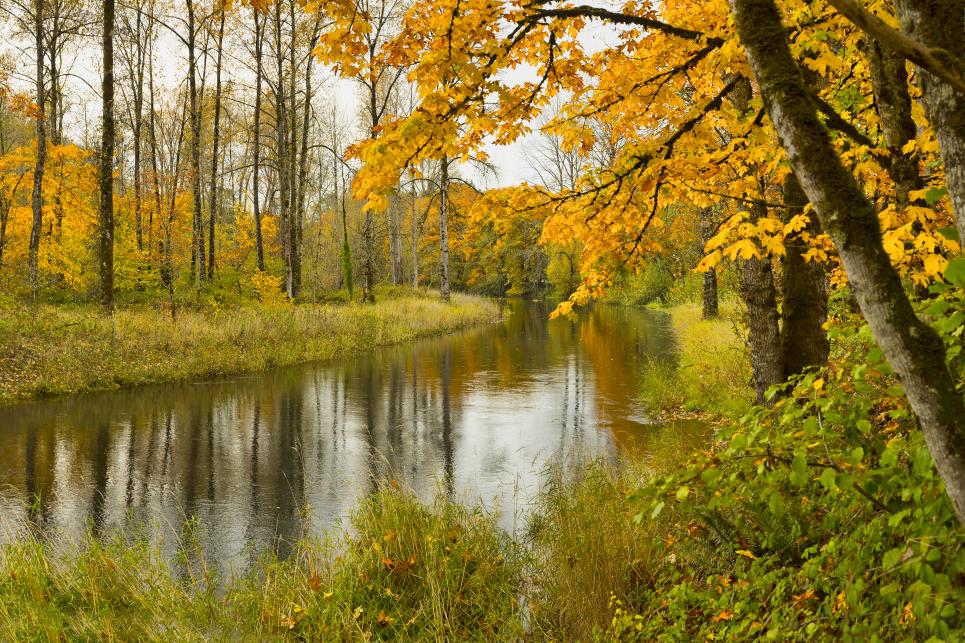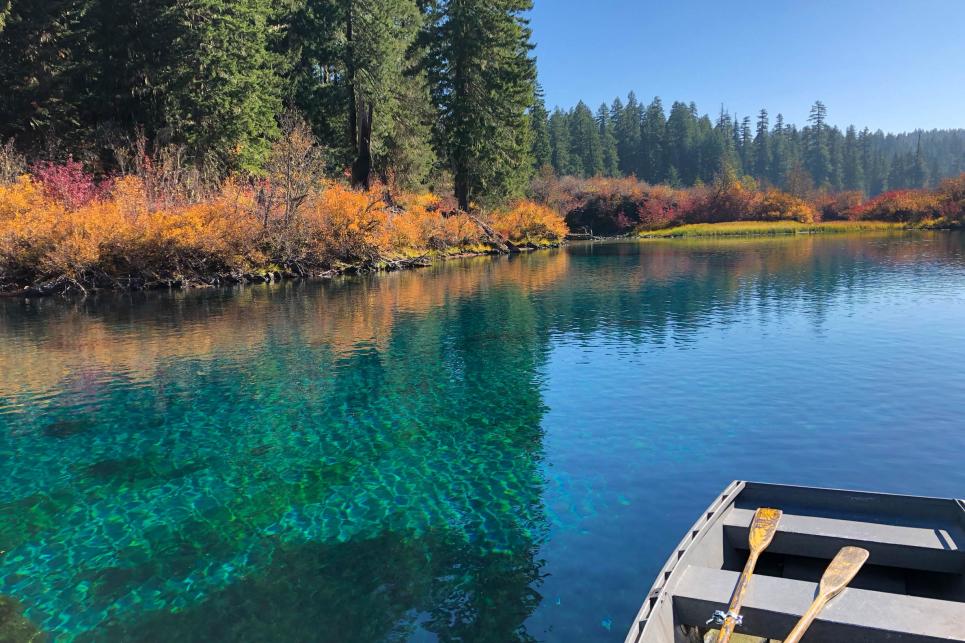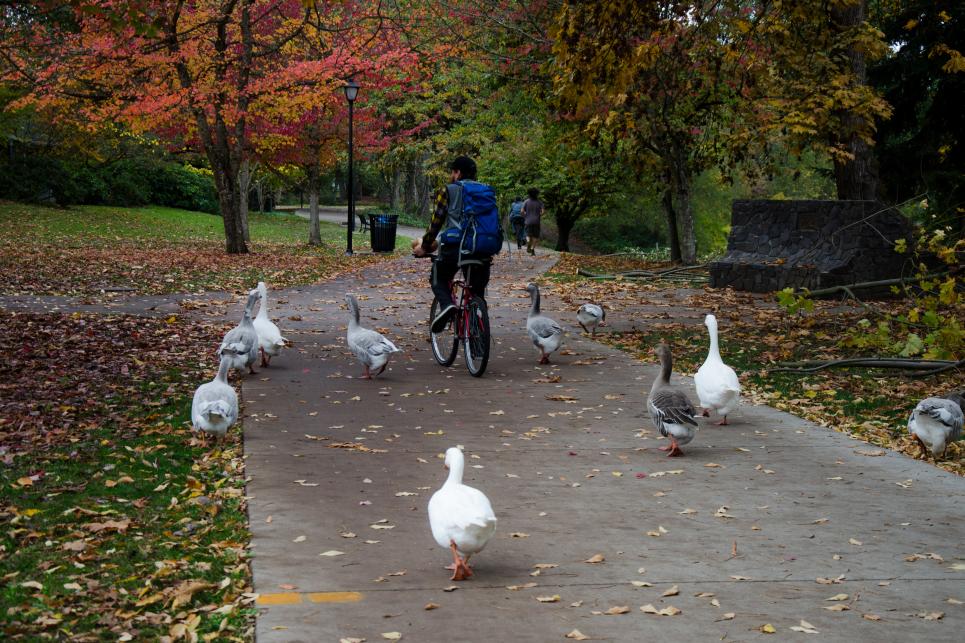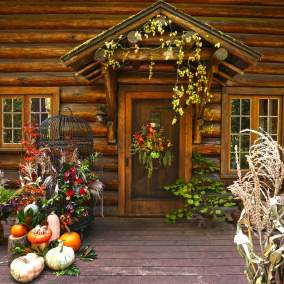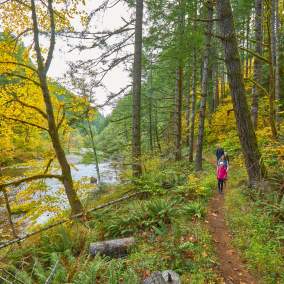Oregon is a great fall destination for enjoying changing leaf color. Autumn is cool and crisp, but still sparkles with many sunshine-filled days. The striking reds, oranges and yellows pop against a deep green backdrop of the evergreen Douglas fir (Oregon's state tree), giant sequoias and ponderosa pine. Almost half of Oregon is forested with the majority of trees in the western parts of the state. Christmas tree farming is also a prime agricultural resource here.

Colorful fall leaves on the University of Oregon campus in Eugene.
When and Where do Leaves Change Color in Oregon?
Oregon's peak color is mid-October, sometimes starting with a golden blush in the first weeks of September and sometimes lingering with bright red leaves clinging onto skeleton branches into early November. Touring during the second week of October is probably your best bet, but if catching leaves at their prime is important to you — you may wish to keep tabs on changes by calling local visitor centers for color updates and preparing for a spontaneous visit.
Trees at higher elevations change first, so you'll note that the Cascades, Bend and the coastal range will start showing the signs of fall first. Much of the eastern part of Oregon is high desert while the Willamette Valley — home to Eugene, Portland and Salem — is lower elevation. The valley towns and the communities at sea level along the Oregon Coast like Coos Bay, Florence and Seaside, will be some of the last areas to peak. However; don't forget to keep in mind that regions to the north get cooler first, so the wave of fall color will sweep down, from both north to south and high to low.
The total show of color typically lasts two to three weeks depending on weather patterns. For maximum unfurling, start in the Mount Hood area or the Gorge and gradually travel southwest, perhaps passing through Eugene and ending in Florence.
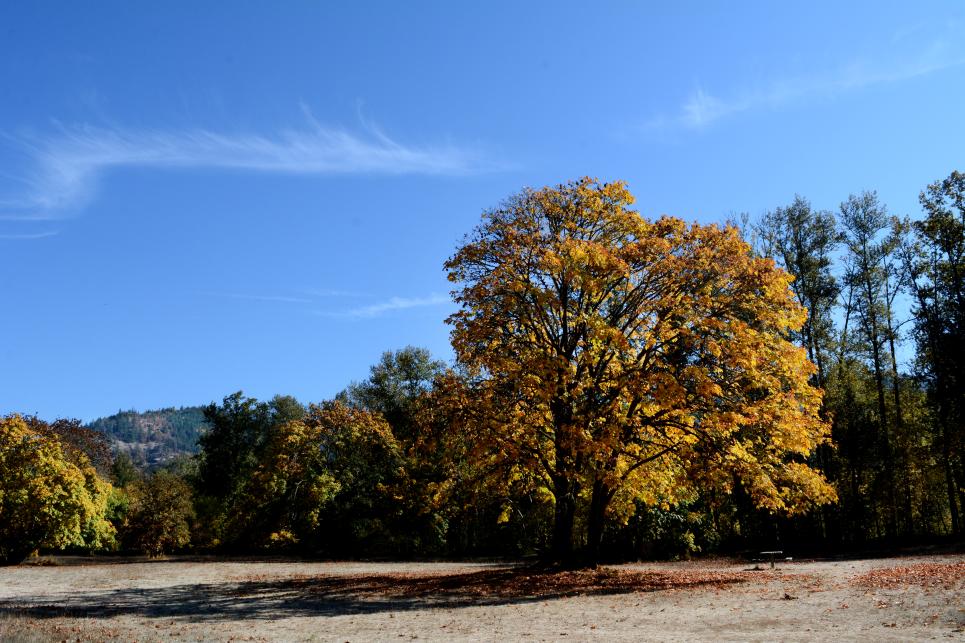
Creswell's Lynx Hollow Park in fall.
What are Oregon's most colorful trees?
The Pacific Northwest has a variety of robust fall favorites, all set against a stunning backdrop of evergreens, old growth forest, stark black lava rock, rugged coastline and golden valleys. Common trees you will spot include:
Maples (yellow and red)
There are three maples native to Oregon—the big leaf maple, the vine maple and the Rocky Mountain maple. The big leaf maple has large leaves that turn gold and yellow. These trees can live for as long as 300 years. The vine maples are a smaller, bushy tree with leaves that individually change from bright green to varying hues of red. The Rocky Mountain maple is more spindly and its leaves change from light green to reddish-orange. There are nine other maples native to the Pacific Northwest that can be spotted here too. Beautiful but invasive ornamental maples include the Norway maple, Sycamore maple and Japanese maples.
Dogwoods (red and burgundy)
The Pacific dogwood and the Western dogwood (a shrub) are native to the Pacific Northwest. Dogwoods are distinctive for their white or pink leaves that surround their flowers. Leaves turn red and burgundy and start to drop in the fall. In addition to the native trees, there are a variety of other ornamental dogwoods that have been planted across the state.
Oak (orange and brown)
The Oregon white oak (Garry oak) is a common deciduous in Oregon that is native to the west coast. Tolerant to both fire and flooding, this sturdy tree populated the Willamette Valley as oak savannas. The leaves turn an orange to brown hue and often cling to the branches until new buds push them off in the spring.
Ash (yellow)
The Oregon ash is native to the state and loves soggy ground. Its pinnately compound leaves start as olive green and turn yellow in the fall.
Birch (yellow)
The paper birch with bright white bark, and the water birch with brown to black bark, can both be found in Oregon. Their leaves are small with serrated edges and turn yellow in fall.
Alder (green and yellow brown)
Oregon has four alders — the red alder, white alder and the more shrubby Sitka and thin leaf alders. Alders produce tiny cones and the small, serrated leaves alternate. In autumn they stubbornly remain green, even having fallen, at most turning a dingy yellowy brown.
Aspen (bright yellow and gold)
These small, short-lived trees are common in much of the United States but but rarer in Oregon. However, you will find the quaking aspen in the upper Cascades and in the eastern part of the state. Their alternate oblong leaves turn brilliant yellow hues.
Cottonwoods (yellow)
Found along rivers and streams, these trees offer triangular leaves that turn yellow in fall.
Horsechesnut (yellow)
A large broadleaf tree with inedible nuts offers white flowers in spring and yellow leaves in autumn.
Larch (yellow, drop needles)
The larch (tamarack) is a conifer pine tree with short needles that turn gold in the fall. This tree grows tall, making it a target for lightning, and in the winter it towers, barren, above the forests.
Other trees
Look for black walnuts, dawn redwoods (a rare deciduous conifer) and magnolias.
What are some colorful Oregon destinations for fall?
From heritage trees across the cities to natural arboretums, there are many places to spot bright autumn colors. Here are some top spots for Oregon's beautiful fall foliage.
-
The Gorge — This northern canyon route is a knock out road trip destination for leaf changes.
-
Mount Hood — One of the first places to blush with color, Mount Hood draws visitors across the state.
-
Hoyt Arboretum — In Portland, this woodsy park features over 2,000 distinct trees.
-
Portland Japanese Garden — Twelve acres of beautifully designed gardens showcase autumn magnificently.
-
Oregon Garden — Silverton's botanical garden is a resort property with 80 acres of landscaping. As the cooler months arrive, they dress the gardens with holiday lights.
-
Peavy Arboretum at Oregon State University (Corvallis)
-
Lithia Park in Ashland
-
Mount Pisgah Arboretum in Eugene — Over 200 of acres showcase a variety of landscapes from woodlands to meadows.
-
Dorris Ranch in Springfield — Walk through this historic hazelnut orchard along riverfront paths to Clearwater park for optimal fall viewing.
-
Shore Acres State Park on the Oregon Coast — Enjoy the coastal gardens and forests right on the edge of the ocean.

Detering Orchards Pumpkin Patch
Add on activities for an Amazing Fall Experience
Scout Leaves by Boat
Viewing leaves from the highways and back country roads is lovely, but have you considered how autumn looks from the waterways? Tranquil scenes of trees trailing their leaves in the water, spots of color floating in the rapids, nature unspoiled by roads, cars and congestion. Enjoy the unique perspective from the middle of the river back to the river's banks!
The Willamette River courses through Portland, Eugene, Oakridge and other small towns. The Siuslaw River winds to the coast and the Rogue River drops down from the mountains. Hire a jet boat for a comfortable ride, often with the benefits of a knowledgeable guide, a great bottle of wine and the warm glow of late afternoon.
Watch for Birds and Wildlife
The trees are not without their friends! Among the colorful leaves, squirrels and chipmunks frisk, and birds and turkeys roost. Spot deer, bears, foxes, skunks, possums, raccoons, beavers and more. There are places to stop like the butterfly pavilion and elk meadow on Highway 38 or the Sea Lion Caves and whale watching points along Highway 101. Or you can visit the Cascades Raptor Center in Eugene, the Portland Zoo or the Wildlife Safari. Domestic animals spot the farm fields, and you can get a close up look at alpacas at Aragon Alpacas in Eugene.

Fall in the Vineyards
Go Wine Tasting
Ramble the Willamette Valley enjoying Oregon Wine Country in its golden harvest days.
Tour Historic Covered Bridges
In the Eugene, Cascades & Coast region there are twenty preserved covered bridges, some that you can even drive through. Marvel at their architectural designs and nostalgic appeal. Framed by the colorful leaves, these beloved historic treasures make for a memorable collection of photos.
Discover Murals and Street Art
Wandering the roads will take you through small towns with magnificent artistic tributes to their past and present. Take time to find and enjoy the local murals and street art.
